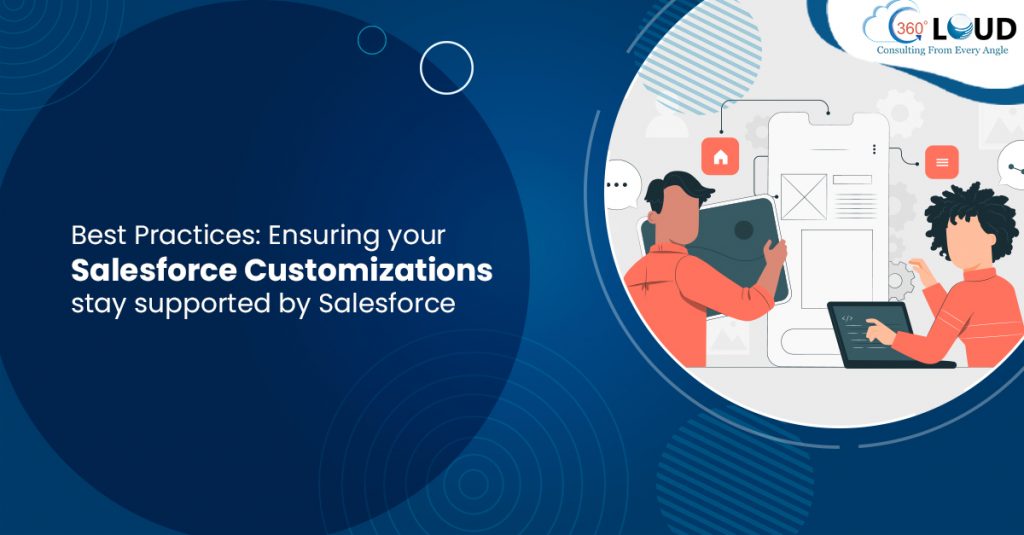Salesforce is highly known to be an adaptable platform. And whether you’re working on Salesforce customization to meet new business needs or you’ve found a new feature that you never knew existed, you should always make sure it is implemented safely. This is why it is important to be aware of the best practices for ensuring your Salesforce customizations stay supported by Salesforce.
Ensuring your Salesforce Customizations stay supported by Salesforce
For a new Salesforce instance, there will be a lot of features you might wish to customize to fit your business. And if you’re customizing the org, many parts of your Salesforce system may have already been adapted. So whatever you are going to customize, it is likely to affect other existing features in Salesforce. So, make sure that when you choose from the types of Salesforce customization to get it implemented, it won’t have any negative impact.
So, we have brought some of the best practices of Salesforce customization that you must consider before going for it.
1. Know the Right Way
When there is a request for Salesforce customization, there can be many ways to implement new customization. This is why sometimes you need some time to assess your options. There can be solutions that are more adaptable and manageable than others.
Many Salesforce developers might find it tempting to code something instead of building out the same functionality through standard features. However, it’s always a better practice to configure as much as possible using the standard features and then move to Apex when there is no other option.
2. Focus on Great Planning for Great Execution
When you are set on how to customize Salesforce, you must get a plan on how you’re going to execute and deploy your development.
Making a plan can help you in many ways. Firstly, it gives you a chance to put down on paper what you are doing. This gives you a reference that you can verify again down the road. This will be helpful in both the case of developing and testing your customizations that can impact your organization.
Secondly, a plan helps organize and prioritize everything customization is going to do in the right order. This is important as a lot of features are interdependent, which means you will need to make some customizations before others. So proper planning will make your customization project efficient.
3. Always Use the Sandbox
Although it is tempting to make quick customizations, it isn’t worth the risk of potentially breaking your system without having the ability to roll back. A sandbox can create your Salesforce customizations in a safe environment and test, ensuring that without affecting other users or your system.
There are a few sandbox options, so here is a general brief on using these Salesforce sandboxes.
- Developer Sandbox – This sandbox is great for new customizations and testing them with fresh test data. It is possible as the developer sandbox is created without any data at all. This ultimately provides you a clean system without any mess of data that already exists.
- Partial Sandbox – With a partial sandbox, you get a sample data set added to your system. This attribute allows you to see the possible effect of customization on your data.
- Full Sandbox – The ultimate sandbox is a full copy of your org and enables you to deploy your new customizations to see how it will look in your system. This sandbox is usually helpful for final testing before deploying the customization live.
4. Get the Expert Help
There are a huge array of Salesforce features, and it can be hard to master customizing them all without making any mistake. So if the customization you need is out of your depth, getting help from someone more qualified and experienced would be the right move.
Although it may seem expensive at first, hiring the right team will save you money in the long run. There can be situations when features might get implemented incorrectly and end up affecting other existing features in Salesforce. This means you will ultimately end up hiring a Salesforce expert to fix everything anyway!
5. Use the Right Tools
If the Salesforce customization you need for your business is complex, you may need some tools to help you feel more confident that you aren’t affecting any feature in the existing system.
Having the right tools can prove to be a great support in the Salesforce customization process. It shows you the impact your customizations may have on other features. It also helps you release the new features safely and securely.
Winding Up
We have covered here the best practices that will help you customize Salesforce to fit your business needs. And with the support of an experienced Salesforce implementation service, you can also gain the confidence needed to implement other more complicated customizations.
We love to help make sure you can customize and deploy features safely to your Salesforce org, so be sure to check out our Salesforce blogs for some tips and tricks of the trade! You can also contact us to know more about Salesforce customization or avail an array of Salesforce-based services.
